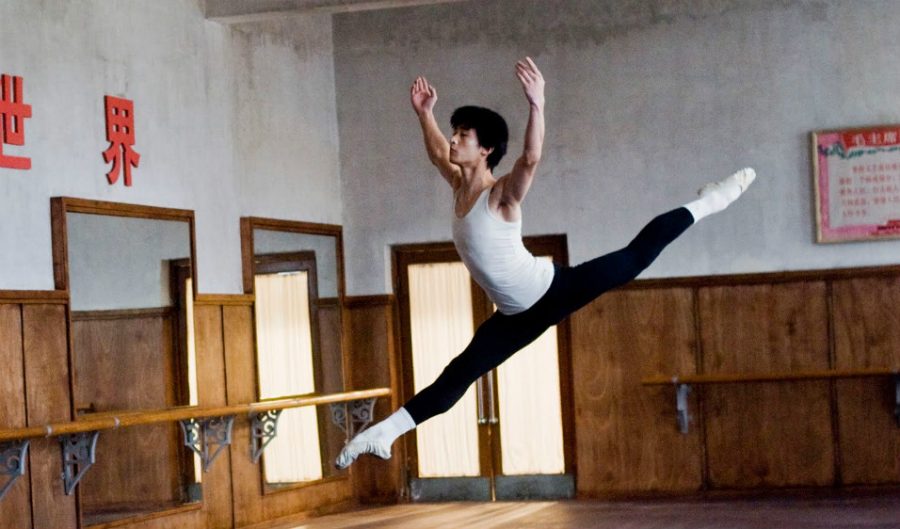‘Mao’s Last Dancer’ in review
From restricted red to artistic freedom
More stories from Lara Bockenstedt
Photo by SUBMITTED
Li Cunxin dances in one of the ballet academy’s practice rooms in “Mao’s Last Dancer.”
When Western art was considered treasonous and with Mao’s little red book their guide, a young peasant in communist China is chosen by Madame Mao’s cultural delegates to leave his family for a rigorous ballet school in Beijing.
The sparks ignited at this school turned into an eventual and successful career in the United States. “Mao’s Last Dancer” follows Li (Chi Cao) undergoing training at the school and his newfound life in Houston until the parallel timelines end and he makes the controversial decision to stay in the U.S.
His life prior to being selected by the delegates largely revolved around manual work. Labor and routines are emphasized in every movement during these shots. When the delegates interrogate his parents to test their devotion to the party, they are pleased to find his family has lived as peasants throughout the centuries.
He moves to the boarding school where his body is literally stretched and trained beyond what one would expect for a young 11-year-old. The counts “Yi, er, san, si,” or “one, two, three, four” surround him like the fast tempo inside the academy walls.
While Madame Mao’s (Xiu Qing Yue) cultural delegates prized anything favoring the revolution, art beyond romanticizing the work of peasants, soldiers and workers was forbidden. When a professor who prizes the softness of western ballet over propaganda dancing is sent away (to prison, the viewer assumes), he smuggles a VHS of Mikhail Baryshnikov dancing to Li.
Li watches the dancer move across the stage and through the air and says the same words I thought: It looks as though Baryshnikov is flying. He begins to train intensively on his own time. He is noticed by touring dancers from Houston and is chosen to study in Texas for a summer.
Surprisingly, the transitions between Chinese gardens in Beijing and the mountain village in Houston are flawless.
His initial impression of the U.S. can be seen in the first five minutes of leaving the airport when Li encounters a large group of multi-racial, multi-cultural Americans.
“When in doubt,” he’s told by the Chinese Consul in Houston, “let your communist principles guide you.”
In navigating the tricky balance of how to fit in with American culture, his journey accentuates distasteful materialism of the U.S.: an abundance of clothes, food and extravagant nights out while Li’s parents continue their labor day in and day out.
Eventually, he meets a young woman and they start dating. He befriends fellow dancers and his coach. Slowly, he becomes comfortable expressing how happy he is in the U.S. When Li decides to stay in the U.S., his friends are the ones who stand up for him and make sure he isn’t discreetly sent back in the dead of night.
Ballet is a survival tactic and eventual art in Li’s life, but the relationship with his parents is the real heart of the story. It’s gripping to watch his mother sew a quilt for him through the night as her little boy prepares to leave and his father gives him a pen.
This pen had been given to Li’s father by Li’s grandfather who had ambitions for him to learn how to read and write. While Li’s father couldn’t fulfill this dream, the gift conveyed the father’s belief his sixth son would.
Communist elements are conveyed through color. When Li is 11 and living with his family, red is the sole vibrant color against a palette of laborious monochromatics. Especially in Beijing, the blood red stands as a reminder that there is always someone watching.
Whenever Li receives advice from communist leaders, an image of Mao hangs somewhere in the fore or background, keeping watch. I went to Beijing a few years ago. While Mao’s little red book could be found in souvenir shops with images of him hung in everyday areas like grocery stores—and most famously, Tiananmen Square—as residue of a restrictive time period.
It is clear through the narrative how trapped Li felt by Mao’s communism and the freedom ballet gave him. The story jumps around a lot, but maintains its integrity as a tribute to Mao’s last ballet dancer.
“Mao’s Last Dancer” will be playing in Woodland Theatre at 7 p.m. Friday, at 2 p.m. and 7 p.m. Saturday and at 2 p.m. Sunday.


